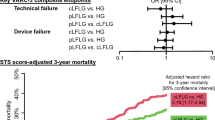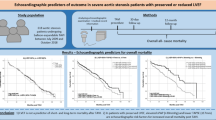Abstract
Literature of patients with severe high-gradient aortic stenosis (HG AS) (mean pressure gradient [MPG] ≥ 40 mmHg and aortic valve area [AVA] ≥ 1.0 cm2) remains limited. This study seeks to compare the prognostic outcomes of patients with high-gradient concordant (HGCON-AS) and discordant AS (HGDIS-AS) in an Asian cohort. From 2010 to 2015, patients with moderate-to-severe AS with preserved left ventricular ejection fraction (LVEF ≥ 50%) were recruited and stratified into 3 groups based on index echocardiogram—(1) HGDIS-AS, (2) HGCON-AS and (3) moderate AS (MOD-AS). The primary study endpoints was all-cause mortality, with secondary endpoints of congestive heart failure (CHF) admissions and aortic valve replacement (AVR). Multivariable Cox regression was used and Kaplan–Meier curves were constructed to evaluate associations between HGDIS-AS, HGCON-AS and MOD-AS, and the study outcomes. A total of 467 patients were studied, comprising of 6.2% HGDIS-AS, 13.9% HGCON-AS and 79.9% MOD-AS patients. There was significantly higher AVR rates in the HGCON-AS group (58.5%), followed by HGDIS-AS (31.0%) and MOD-AS (4.6%), p < 0.001) groups. After adjusting for confounders, HGCON-AS was significantly associated with all-cause mortality (HR 3.082, 95% CI 1.479–6.420, p = 0.003) and CHF admissions (HR 12.728, 95% CI 2.922–55.440 p = 0.001) but not HGDIS-AS, with MOD-AS as the reference group. Both HGDIS-AS (HR 7.715, 95% CI 2.927–20.338; p < 0.001) and HGCON-AS (HR 21.960, 95% CI 10.833–44.515, p < 0.001) were independent predictors of AVR. After exclusion of reversible high-flow states, HGDIS-AS patients appear to have a more favourable prognostic profile compared to HGCON-AS patients. Large prospective interventional studies examining the prognostic differences between the two groups will be the next important step.

Similar content being viewed by others
References
Tang L, Gössl M, Ahmed A et al (2018) Contemporary reasons and clinical outcomes for patients with severe, symptomatic aortic stenosis not undergoing aortic valve replacement. Circ Cardiovasc Interv 11(12):e007220
Clavel MA (2016) Echocardiographic assessment of aortic stenosis severity: do not rely on a single parameter. J Am Heart Assoc. https://doi.org/10.1161/JAHA.116.004680
Minners J, Allgeier M, Gohlke-Baerwolf C, Kienzle R-P, Neumann F-J, Jander N (2008) Inconsistencies of echocardiographic criteria for the grading of aortic valve stenosis. Eur Heart J 29(8):1043–1048
Bevan GH, Zidar DA, Josephson RA, Al-Kindi SG (2019) Mortality due to aortic stenosis in the United States, 2008–2017. JAMA 321(22):2236–2238
Nishimura RA, Otto CM, Bonow RO et al (2014) 2014 AHA/ACC guideline for the management of patients with valvular heart disease: executive summary: a report of the American College of Cardiology/American Heart Association Task Force on Practice Guidelines. J Am Coll Cardiol 63(22):2438–2488
Vahanian A, Iung B (2012) The new ESC/EACTS guidelines on the management of valvular heart disease. Arch Cardiovasc Dis 105(10):465–467
Baumgartner H, Hung J, Bermejo J et al (2009) Echocardiographic assessment of valve stenosis: EAE/ASE recommendations for clinical practice. J Am Soc Echocardiogr 22(1):1–23
Berthelot-Richer M, Pibarot P, Capoulade R et al (2016) Discordant grading of aortic stenosis severity: echocardiographic predictors of survival benefit associated with aortic valve replacement. JACC Cardiovasc Imaging 9(7):797–805
Vulesevic B, Burwash IG, Beauchesne LM et al (2020) Outcomes of patients with discordant high-gradient aortic valve stenosis. JACC Cardiovasc Imaging 13(7):1636–1638
Barbieri A, Antonini-Canterin F, Pepi M et al (2020) Discordant echocardiographic grading in low gradient aortic stenosis (DEGAS study) from the Italian society of echocardiography and cardiovascular imaging research network: rationale and study design. J Cardiovasc Echogr 30(2):52–61
Clavel MA, Magne J, Pibarot P (2016) Low-gradient aortic stenosis. Eur Heart J 37(34):2645–2657
Dayan V, Vignolo G, Magne J, Clavel MA, Mohty D, Pibarot P (2015) Outcome and impact of aortic valve replacement in patients with preserved LVEF and low-gradient aortic stenosis. J Am Coll Cardiol 66(23):2594–2603
Quiñones MA, Otto CM, Stoddard M, Waggoner A, Zoghbi WA (2002) Recommendations for quantification of Doppler echocardiography: a report from the Doppler quantification task force of the nomenclature and standards committee of the American Society of Echocardiography. J Am Soc Echocardiogr 15(2):167–184
Minners J, Allgeier M, Gohlke-Baerwolf C, Kienzle RP, Neumann FJ, Jander N (2010) Inconsistent grading of aortic valve stenosis by current guidelines: haemodynamic studies in patients with apparently normal left ventricular function. Heart 96(18):1463–1468
Chew NWS, Ngiam JN, Tan BY et al (2020) Echocardiographic discrepancies in severity grading of aortic valve stenosis with left ventricular outflow tract (LVOT) cut-off values in an Asian population. Int J Cardiovasc Imaging 36(4):615–621
Baumgartner H, Falk V, Bax JJ et al (2017) 2017 ESC/EACTS guidelines for the management of valvular heart disease. Eur Heart J 38(36):2739–2791
Baumgartner HC, Hung JC-C, Bermejo J et al (2017) Recommendations on the echocardiographic assessment of aortic valve stenosis: a focused update from the European Association of Cardiovascular Imaging and the American Society of Echocardiography. Eur Heart J Cardiovasc Imaging 18(3):254–275
Otto CM, Nishimura RA, Bonow RO et al (2021) 2020 ACC/AHA guideline for the management of patients with valvular heart disease: executive summary: a report of the American College of Cardiology/American Heart Association Joint Committee on Clinical Practice Guidelines. Circulation 143(5):e35–e71
Nashef SA, Roques F, Sharples LD et al (2012) EuroSCORE II. Eur J Cardiothorac Surg 41(4):734–744 (discussion 744–735)
Whelton PK, Carey RM, Aronow WS et al (2018) 2017 ACC/AHA/AAPA/ABC/ACPM/AGS/APhA/ASH/ASPC/NMA/PCNA guideline for the prevention, detection, evaluation, and management of high blood pressure in adults: executive summary: a report of the American College of Cardiology/American Heart Association Task Force on Clinical Practice Guidelines. Hypertension 71(6):1269–1324
Bonow RO, Carabello BA, Kanu C et al (2006) ACC/AHA 2006 guidelines for the management of patients with valvular heart disease: a report of the American College of Cardiology/American Heart Association Task Force on Practice Guidelines (writing committee to revise the 1998 guidelines for the management of patients with valvular heart disease): developed in collaboration with the Society of Cardiovascular Anesthesiologists: endorsed by the Society for Cardiovascular Angiography and Interventions and the Society of Thoracic Surgeons. Circulation 114(5):e84-231
Vahanian A, Baumgartner H, Bax J et al (2007) Guidelines on the management of valvular heart disease: the task force on the management of valvular heart disease of the European Society of Cardiology. Eur Heart J 28(2):230–268
Lang RM, Badano LP, Mor-Avi V et al (2015) Recommendations for cardiac chamber quantification by echocardiography in adults: an update from the American Society of Echocardiography and the European Association of Cardiovascular Imaging. J Am Soc Echocardiogr 28(1):1-39.e14
Chyrchel B, Długosz D, Bolt K et al (2018) Association of inadequately low left ventricular mass with enhanced myocardial contractility in severe degenerative aortic stenosis. J Clin Med 7(12):464
Chew NWS, Ngiam JN, Tan BY et al (2021) Inadequately low left ventricular mass in patients with significant aortic stenosis predicts favourable prognostic outcomes. Int J Cardiovasc Imaging 37(5):1611–1619
Długosz D, Bolt K, Sam WS et al (2018) Excessive left ventricular hypertrophy in moderate degenerative aortic stenosis: an ineffective compensatory mechanism triggered by primary myocardial dysfunction and enhanced by concomitant mild renal impairment? Kardiol Pol 76(10):1486–1488
Minamino-Muta E, Kato T, Morimoto T et al (2017) Impact of the left ventricular mass index on the outcomes of severe aortic stenosis. Heart 103(24):1992
Bohbot Y, Kubala M, Rusinaru D, Maréchaux S, Vanoverschelde JL, Tribouilloy C (2021) Survival and Management of Patients With Discordant High-Gradient Aortic Stenosis: A Propensity-Matched Study. JACC Cardiovasc Imaging. https://doi.org/10.1016/j.jcmg.2021.02.010
Chew NW, Kong G, Ngiam JN et al (2021) Comparison of outcomes of asymptomatic moderate aortic stenosis with preserved left ventricular ejection fraction in patients≥ 80 years versus 70–79 years versus< 70 years. Am J Cardiol 157:93–100
Stassen J, Ewe SH, Butcher SC et al (2021) Moderate aortic stenosis: importance of symptoms and left ventricular ejection fraction. Eur Heart J. https://doi.org/10.1093/ehjci/jeab242
Pai RG, Varadarajan P, Razzouk A (2008) Survival benefit of aortic valve replacement in patients with severe aortic stenosis with low ejection fraction and low gradient with normal ejection fraction. Ann Thorac Surg 86(6):1781–1789
Michelena HI, Margaryan E, Miller FA et al (2013) Inconsistent echocardiographic grading of aortic stenosis: is the left ventricular outflow tract important? Heart 99(13):921–931
Ngiam JN, Chew NW, Tan BY et al (2020) The obesity paradox: association of obesity with improved survival in medically managed severe aortic stenosis. Singapore Med J. https://doi.org/10.11622/smedj.2020169
Ngiam JN, Chew NW, Pramotedham T et al (2021) Implications of coexisting aortic regurgitation in patients with aortic stenosis. JACC: Asia 1(1):105–111
Chew N, Hon JKF, Yip WLJ et al (2017) Mid-term study of transcatheter aortic valve implantation in an Asian population with severe aortic stenosis: two-year Valve Academic Research Consortium-2 outcomes. Singapore Med J 58(9):543–550
Author information
Authors and Affiliations
Contributions
NWSC: Conceptualization, Data curation, Methodology, Formal analysis, Writing—Original draft, Writing—Review and Editing, Supervision. YJH: Data curation, Methodology, Formal analysis, Writing—original draft. JHNN: Writing—Review and Editing. GK: Data curation, Methodology, Formal analysis, Writing—original draft. YHC: Writing—Review and Editing. OZHL: Writing—Review and Editing. CL: Writing—Review and Editing. C-HS: Writing—Review and Editing. P-HL: Writing—Review and Editing. IK: Writing—Review and Editing. RCCW: Writing—Review and Editing. WKFK: Writing—Review and Editing. T-CY: Writing—Review and Editing. K-KP: Writing—Review and Editing, Supervision. All authors read and gave final approval of the version to be submitted.
Corresponding authors
Ethics declarations
Conflict of interest
All authors declare no conflict of interest.
Additional information
Publisher's Note
Springer Nature remains neutral with regard to jurisdictional claims in published maps and institutional affiliations.
Rights and permissions
About this article
Cite this article
Chew, N.W.S., Ho, Y.J., Ngiam, J.H.N. et al. Clinical, echocardiographic and prognostic outcomes of patients with concordant and discordant high-gradient aortic stenosis in an Asian cohort. Int J Cardiovasc Imaging 38, 1351–1360 (2022). https://doi.org/10.1007/s10554-022-02524-z
Received:
Accepted:
Published:
Issue Date:
DOI: https://doi.org/10.1007/s10554-022-02524-z




